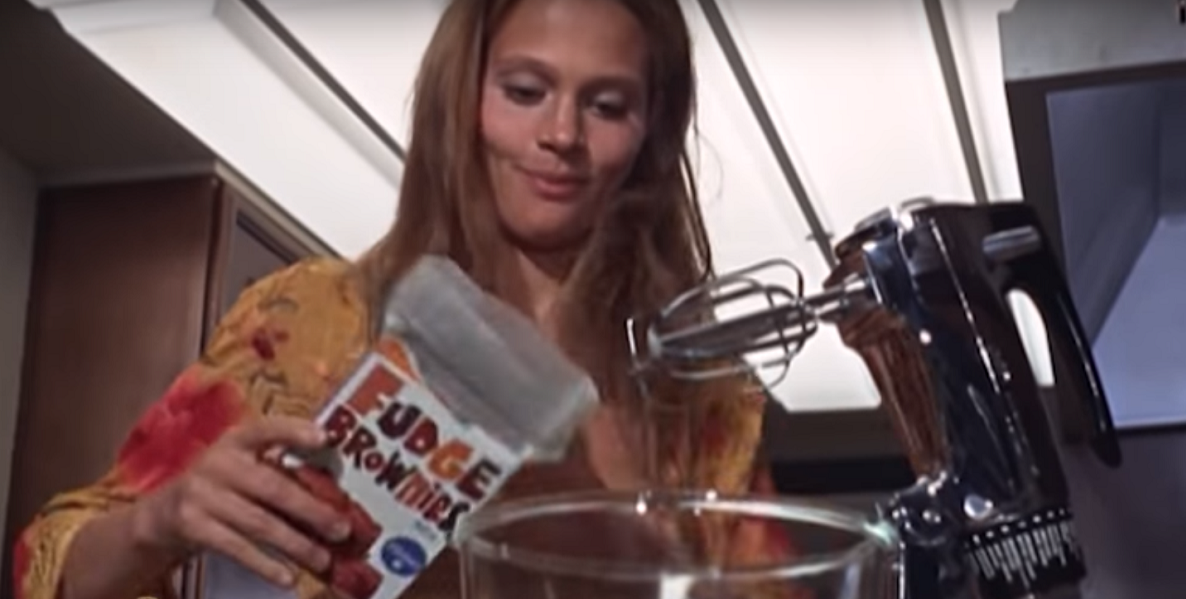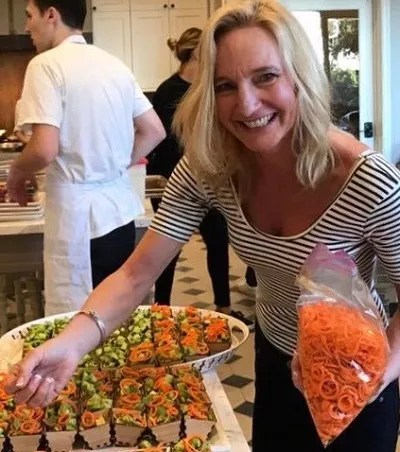
YouTube/Warner Archive

Audio By Carbonatix
Did you know that pot brownies became popular by mistake? Or that one of the world’s earliest edible recipes was used by a band of assassins? The history of cooking with cannabis starts over a thousand years ago, comes to a screeching halt in the twentieth century, then moves at light speed after 2012.
Already riding high off the success of her first foray into cannabis literature, The Cannabis Kitchen Cookbook, author and journalist Robyn Griggs Lawrence – a self-described “digital nomad” who lived in Boulder for many years – now dives into humanity’s long relationship with eating cannabis in Pot in Pans: A History of Eating Cannabis. In this new book, Lawrence describes the ancient eating habits of Chinese and Persian cultures while teaching us about our own country’s past with the plant.
We caught up with Lawrence to learn more about the history of eating cannabis and some of her favorite infused snacks.
Westword: What pushed you toward writing about cannabis?
Robyn Griggs Lawrence: Before this, I was in the green homes and lifestyle field. I did a lot of writing about that, which weirdly does come into play here. I came into cannabis as a patient. I discovered it as another piece in my natural and holistic tool kit. It really helped me as a patient, but I also realized I’d rather cook with it than smoke it. But this was back in 2009, and trying to find any information on how to cook with cannabis was almost impossible. There was a lot of misinformation online, and people in those online forums – which was where you had to go for cannabis information back then – were always arguing and bickering with each other.
I wanted to do this, but it seemed scary. Being a journalist, though, I started calling chefs and asking them to help me learn how to do this and write a book about it. All of them were so willing to teach me what they knew and share recipes, and that was my introduction to the cannabis industry. It was spectacular, and it reminded me how the natural and green building industry was in the beginning. There was a collegiate feeling there, and everyone was in it together, and for a good mission. I just realized that was my next place, and I wanted to be a part of this movement that brought this medicine to the masses.
How far have you seen cannabis cooking and commercial edibles come since then?
In legal states, it’s night and day, but I’m absolutely amazed that the majority of people still have no idea what it means to cook with cannabis. Most think it’s just throwing cannabis into a brownie mix and calling it a day. Overall, I’d say we have a ton of work to do, but in legal states, it’s amazing to see what’s going on. There was no such thing as water-soluble THC when I first starting doing this, and that’s such a game-changer.
Funny you mention that, because THC and CBD distillate powders make cooking with cannabis so easy that some of our readers are disappointed when we tell them they no longer have to change the recipes.
Right? [Laughs.] That does take some of the artistry and mystique from it. I kind of had that sentiment when I discovered Ripple and Ebbu and that kind of stuff – like no one was going to need my books anymore. Uh-oh, right? But with anything, there’s always going to be that artisanal factor. There are always going to be people who want to learn to do it for the craft of it rather than stirring it into their coffee. And there’s room for both, always.
I think the people who want to get into this are the people who were interested in cooking from the beginning. But to have something for the people who need it to just stir into their tea or something is also spectacular. To watch the evolution, though, has been fascinating. When I started, there was no such thing as pop-up cannabis dinners. If there were, they were super-secret, no one could hear about them, and only prestigious people got to go. Now, they’re a thing, so it’s cool see these things happen.
Your most recent book, Pot in Pans, touches on how humans ate cannabis nearly 1,000 years ago. How were they doing it, and what for?
It depends on the culture, because different cultures used it for many different reasons. The first recorded instances of it were in China, but it was more about nutrition and medicine. The hemp side was emphasized more, and the psychoactive part was considered an unfortunate side effect. But in Persia, where alcohol was never allowed, cannabis was embraced much more for the psychoactive effects. It was used more as an intoxicant and a relaxant. This was thousands of years ago, though.

Robyn Griggs Lawrence prepares a dish during a dinner she’s catering.
Courtesy of Robyn Griggs Lawrence
We’ve been using it as food and medicine for so long, and the history of it is so deep until you get to 1937, where it just stopped.
The books also covers majoun, which is one of my favorite edibles – and something you can’t find at dispensaries in America. Can you explain what majoun is, and why it’s intertwined with eating cannabis in the Eastern part of the world?
Majoun was a Persian confection that was made using dates, nuts and cardamom and all the spices over there. And there was a man in the eleventh century who was a big leader of a Muslim sect; they called him “the old man of the mountain.” He had a band of assassins, and legend goes that he used majoun to intoxicate these assassins to do his bidding or whatever evil deed he wanted to do. So that became woven into the tapestry of history, and majoun was always used by many people, and sold in markets until twentieth-century prohibition.
It was something that was part of the culture, and when hippies went over for the Silk Road, it became a part of that whole journey. Then, in the 1950s, Alice B. Toklas wrote her cookbook. She ran out of time while she was writing it, and she asked her friends to send her some recipes. She had a friend in Morocco by the name of Brion Gysin, who thought it would be funny to send it to her. She didn’t even read it. He changed the name of it to “hashish fudge.” That still didn’t stop her; she didn’t read it, and she threw it in the cookbook – and it made the London edition. This was a big scandal then, because in 1955, prohibition was still very fresh.
So it kind of [got] picked up in a 1968 Peter Sellers movie called I Love You Alice B. Toklas. The whole plot line is that he eats these brownies and it changes him. But this is where the switch got made: He asks where these amazing brownies are from, and the girl says it’s from a groovy cookbook by Alice B. Toklas. And that’s what we all remember as the recipe: She throws cannabis in a brownie mix and calls it a day. That’s basically the point where the majoun morphed into the pot brownie, and it all became associated with Alice B. Toklas, who never even imbibed. It was all a crazy confluence of events.
So Alice B. Toklas never featured a pot brownie recipe in any of her books? It was just majoun that was misrepresented in a movie?
Exactly. Isn’t that crazy?
How can people enjoy cannabis-infused meals that feature multiple courses without getting way too high?
The first thing is to keep the amounts of THC low. I don’t think people completely understand that THC has an accumulative effect. By the time you get to that third or fourth course, it’s not just 20 milligrams anymore – it’s over 100 milligrams by that point. You need to be aware of that and how long it can take. The biggest issue I see with people is that they wait a half-hour, don’t feel anything, eat even more, and then they’re screwed. It’s something that you will always have to warn people about.
The other thing is CBD. It can modulate the effects of THC, so I always have CBD on hand if I’m having a dinner party or catering event. It can take the edge off, so you can also serve it as people are eating.
I think we need to be a little careful in only focusing on THC milligrams. There are so many other things that come into play when you’re eating cannabis-infused foods. Because it’s fat-soluble, if you’re eating a dish that’s fatty, it’s going to be stronger. What you’ve already eaten that day, how your mind feels going into it, what kind of situation you’re in, if you feel comfortable, your body weight and chemistry – that all makes a difference. It’s much more complicated than just saying, “I’m serving you 10 milligrams of THC.”
You’ve researched and tried infused dishes that span multiple cultures and parts of the world. What are some of your favorites?
To be honest, the majoun recipe from my first book, The Cannabis Kitchen Cookbook, is one of my favorites. You can dose the balls with whatever amount you want, and they’re portable and delicious. It’s a recipe from my friend Chris Kilham of [natural medicine company] Medicine Hunter, who spent a ton of time on the Silk Road creating that recipe.
When I was growing, one of my very favorites was pesto. When I’d hit the fall, I’d make a pesto and freeze it, then have that through the year. That was great. Scott Durrah makes a roast pork in my cookbook, and it’s to die for. Oh, my God. We make it for the holidays. I think he’s an amazing chef; that’s one of my go-to’s.